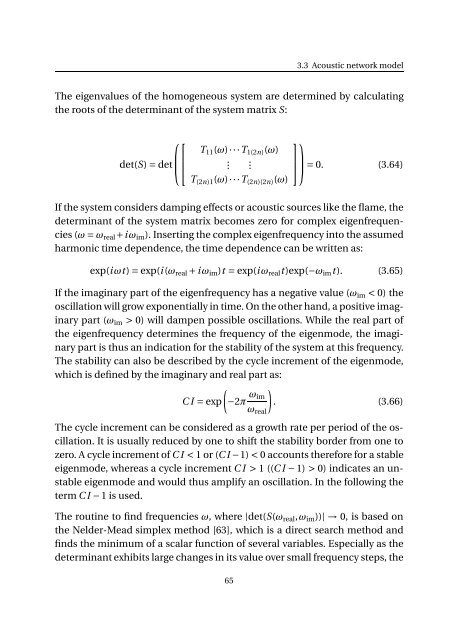Impact of fuel supply impedance and fuel staging on gas turbine ...
Impact of fuel supply impedance and fuel staging on gas turbine ...
Impact of fuel supply impedance and fuel staging on gas turbine ...
You also want an ePaper? Increase the reach of your titles
YUMPU automatically turns print PDFs into web optimized ePapers that Google loves.
3.3 Acoustic network model<br />
The eigenvalues <str<strong>on</strong>g>of</str<strong>on</strong>g> the homogeneous system are determined by calculating<br />
the roots <str<strong>on</strong>g>of</str<strong>on</strong>g> the determinant <str<strong>on</strong>g>of</str<strong>on</strong>g> the system matrix S:<br />
⎛⎡<br />
⎜⎢<br />
det(S)=det⎝⎣<br />
T 11 (ω)···T 1(2n) (ω)<br />
. .<br />
T (2n)1 (ω)···T (2n)(2n) (ω)<br />
⎤⎞<br />
⎥⎟<br />
⎦⎠=0. (3.64)<br />
If the system c<strong>on</strong>siders damping effects or acoustic sources like the flame, the<br />
determinant <str<strong>on</strong>g>of</str<strong>on</strong>g> the system matrix becomes zero for complex eigenfrequencies<br />
(ω=ω real +i ω im ). Inserting the complex eigenfrequency into the assumed<br />
harm<strong>on</strong>ic time dependence, the time dependence can be written as:<br />
exp(i ωt )=exp(i (ω real + i ω im )t = exp(i ω real t )exp(−ω im t ). (3.65)<br />
If the imaginary part <str<strong>on</strong>g>of</str<strong>on</strong>g> the eigenfrequency has a negative value (ω im < 0) the<br />
oscillati<strong>on</strong> will grow exp<strong>on</strong>entially in time. On the other h<str<strong>on</strong>g>and</str<strong>on</strong>g>, a positive imaginary<br />
part (ω im > 0) will dampen possible oscillati<strong>on</strong>s. While the real part <str<strong>on</strong>g>of</str<strong>on</strong>g><br />
the eigenfrequency determines the frequency <str<strong>on</strong>g>of</str<strong>on</strong>g> the eigenmode, the imaginary<br />
part is thus an indicati<strong>on</strong> for the stability <str<strong>on</strong>g>of</str<strong>on</strong>g> the system at this frequency.<br />
The stability can also be described by the cycle increment <str<strong>on</strong>g>of</str<strong>on</strong>g> the eigenmode,<br />
which is defined by the imaginary <str<strong>on</strong>g>and</str<strong>on</strong>g> real part as:<br />
(<br />
C I = exp −2π ω )<br />
im<br />
. (3.66)<br />
ω real<br />
The cycle increment can be c<strong>on</strong>sidered as a growth rate per period <str<strong>on</strong>g>of</str<strong>on</strong>g> the oscillati<strong>on</strong>.<br />
It is usually reduced by <strong>on</strong>e to shift the stability border from <strong>on</strong>e to<br />
zero. A cycle increment <str<strong>on</strong>g>of</str<strong>on</strong>g> C I < 1 or (C I−1) 1 ((C I − 1) > 0) indicates an unstable<br />
eigenmode <str<strong>on</strong>g>and</str<strong>on</strong>g> would thus amplify an oscillati<strong>on</strong>. In the following the<br />
term C I − 1 is used.<br />
The routine to find frequencies ω, where |det(S(ω real ,ω im ))| → 0, is based <strong>on</strong><br />
the Nelder-Mead simplex method [63], which is a direct search method <str<strong>on</strong>g>and</str<strong>on</strong>g><br />
finds the minimum <str<strong>on</strong>g>of</str<strong>on</strong>g> a scalar functi<strong>on</strong> <str<strong>on</strong>g>of</str<strong>on</strong>g> several variables. Especially as the<br />
determinant exhibits large changes in its value over small frequency steps, the<br />
65
















